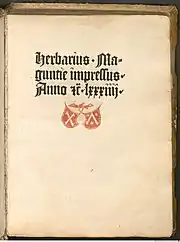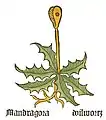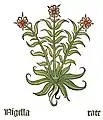Herbarius moguntinus
Herbarius moguntinus (Mainzer Herbal Book) or (according to his preface referred to as) Aggregator practicus de simplicibus is an illustrated Latin herbal which was edited and printed in 1484 by Peter Schöffer in Mainz (Latin: moguntia). Together with the German herbal Gart der Gesundheit (Peter Schöffer, Mainz 1485) and the Latin herbal Hortus sanitatis (Jacobus Meydenbach, Mainz 1491), Herbarius moguntinus belongs to the so-called "Group of Mainz Herbal Incunabula."[1][2][3]


Author
The author of the book is not known for sure. By misinterpreting the title page of a reprint (Vicenza 1491), the book was wrongly attributed to Arnaldus de Villa Nova.[4] As a possible but not secured author the Frankfurt physician Johann Wonnecke von Kaub is assumed.[5]
Sources and content
As primary sources the author of the Herbarius moguntinus used well-known medieval encyclopaedias, such as the Liber pandectarum medicinae omnia medicine simplicia continens of Matthaeus Silvaticus (14th c.) and the Speculum natural of Vincent of Beauvais (13th century).[6][7][8]
The first part of the book consists of 150 chapters, in which plants are described, that grow wild or cultivated North of the Alps. Each chapter in the first part is illustrated by a woodcut of symbolic character. The second part shows 96 other medicines of indigenous and of foreign origin in abbreviated form. Pictures are missing in the second part.[9][10]
Woodcuts in the Herbarius moguntinus. Mainz 1484
 Part I, chapter 6 Agrimonia eupatoria
Part I, chapter 6 Agrimonia eupatoria Part I, chapter 12 Artemisia vulgaris
Part I, chapter 12 Artemisia vulgaris Part I, chapter 15 ... Asarum europaeum
Part I, chapter 15 ... Asarum europaeum Part I, chapter 23 ... Borago officinalis
Part I, chapter 23 ... Borago officinalis Part I, chapter 25 Betonica officinalis
Part I, chapter 25 Betonica officinalis Part I, chapter 28 Capsella bursa-pastoris
Part I, chapter 28 Capsella bursa-pastoris Part I, chapter 31 ... Bryonia dioica
Part I, chapter 31 ... Bryonia dioica Part I, chapter 44 Chelidonium majus
Part I, chapter 44 Chelidonium majus Part I, chapter 50 Dictamnus albus
Part I, chapter 50 Dictamnus albus Part I, chapter 54 ..... Inula helenium
Part I, chapter 54 ..... Inula helenium Part I, chapter 59 Glechoma hederacea
Part I, chapter 59 Glechoma hederacea Part I, chapter 61 Fumaria officinalis
Part I, chapter 61 Fumaria officinalis Part I, chapter 64 Fraxinus
Part I, chapter 64 Fraxinus Part I, chapter 85 ... Achillea millefolium
Part I, chapter 85 ... Achillea millefolium Part I, chapter 92 ... Morus
Part I, chapter 92 ... Morus Part I, chapter 94 Mandragora officinarum
Part I, chapter 94 Mandragora officinarum Part I, chapter 97 Agrostemma githago
Part I, chapter 97 Agrostemma githago Part I, chapter 98 ... Nuphar lutea
Part I, chapter 98 ... Nuphar lutea Part I, chapter 128 Orchis
Part I, chapter 128 Orchis Part I, chapter 136 ... Salix
Part I, chapter 136 ... Salix
Editions and translations
- Mainz. Peter Schöffer 1484.[11]
- Speier. Anonymous 1484
- Leuven. Johann Veldener. Herbarius in Dyetsche. 1484.
- Leuven. Johann Veldener 1485-86.[12]
- Leipzig. Markus Brand 1484.[13]
- Passau. Anonymous 1486.[14]
- Passau. Anonymous 1486 (further edition).[15]
- Paris. Anonymous 1486.
- Vicenza. Achates et Gul. Papia 1491.[16]
- Venice. Bevilaqua (Simon Papia) 1499.[17]
- Venice. Francesco Bindoni and Maffeo Pasini. Herbolario volgare. 1536 [18]
Notes
- Agnes Arber. Herbals. Their origin and evolution. A chapter in the history of botany 1470–1670. University Press, Cambridge 1912, pp. 16–18 (Digitalisat)
- Hermann Fischer. Mittelalterliche Pflanzenkunde. Verlag der Münchner Drucke. München 1929, pp. 74–79.
- Arnold Klebs: Incunabula scientifica et medica. Brügge 1938, p. 169ff. (Reprint Olms, Hildesheim 2004) (Digitalisat)
- Herbarius moguntinus. Ausgabe Vicenza 1491. Titelblatt (Bildlink)
- Gundolf Keil: 'Herbarius Moguntinus' ('Aggregator practicus de simplicibus'; 'Herbarius latinus'). In: Burghart Wachinger et al. (editors): Die deutsche Literatur des Mittelalters. Verfasserlexikon. 2nd edition, ISBN 3-11-022248-5, Band 3: Gert van der Schüren – Hildegard von Bingen. Berlin / New York 1981, column 1017–1025, here column 1073
- Matthaeus (Silvaticus) Moretus. Liber pandectarum medicinae omnia medicine simplicia continens. Bologna 1474 Bayerische Staatsbibliothek Matthaeus (Silvaticus) Moretus. Liber pandectarum medicinae. Straßburg ca. 1480 (Digitalisat)
- Vincentius. Speculum naturale. Straßburg 1481. Vol. I Bayerische Staatsbibliothek Band II (Digitalisat)
- Brigitte Baumann, Helmut Baumann: Die Mainzer Kräuterbuch-Inkunabeln – "Herbarius Moguntinus" (1484) – "Gart der Gesundheit" (1485) – "Hortus Sanitatis" (1491). Wissenschaftshistorische Untersuchung der drei Prototypen botanisch-medizinischer Literatur des Spätmittelalters. Hiersemann, Stuttgart 2010, p. 100.
- Arnold C. Klebs: Herbal facts and thoughts. L’art ancien S. A., Lugano 1925.
- Brigitte Baumann, Helmut Baumann. Die Mainzer Kräuterbuch-Inkunabeln – "Herbarius Moguntinus" (1484) – "Gart der Gesundheit" (1485) – "Hortus Sanitatis" (1491). Wissenschaftshistorische Untersuchung der drei Prototypen botanisch-medizinischer Literatur des Spätmittelalters. Hiersemann, Stuttgart 2010, pp. 104-109 ISBN 978-3-7772-1020-9
- Mainz. Peter Schöffer 1484. Part I and II (Digitalisat). Part I (Digitalisat)
- Leuven. Johann Veldener 1485-6. Part I and II (digitized)
- Leipzig. Markus Brand. Part I and II (digitized)
- Passau. Anonymous 1486. Part I and II (digitized)
- Passau. Anonymous 1486. (further edition). Part I and II (digitized)
- Vicenca. Achates et Gul. Papia 1491. Incomplete copy (digitized)
- Venice. Bevilaqua (Simon Papia) 1499. Part I and II (Digitalisat )
- Herbolario volgare, nel quale se dimostra a conoscer le herbe et le sue virtu ... Venice 1536 (digitized) Includes 19 additional chapters. See also: Hermann Fischer 1929, pp. 78-79